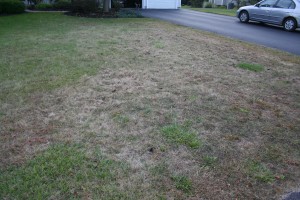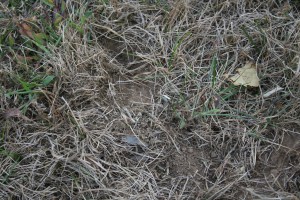Grub damage is showing up in New York later this year than usual, so don’t let your guard down just because it’s October. Still, how do you know if it’s grubs — or something else? One test: if you can loosen the sod with a trowel or garden fork, then peel it up like a carpet, you’ve got grubs. Monitoring, though, is your best bet, and here’s how (pdf) — or watch this video.
Recently I visited distressed homeowners with a lawn so badly infested, I could brush the turf away with a swipe of my fingers. They didn’t want to use pesticides, but they also didn’t know the proper way — mow right, feed right, and water right — to care for their lawn. Given how sandy soil their soil was, their turf showed drought stress despite 2014’s rainy summer. And they had never fertilized.

My IPM recommendations:
- Mow Right: Raise the height of cut on the mower to its highest level and sharpen the blades regularly.
- Feed Right: Provide a fall nitrogen fertilizer application. Conduct a soil test to determine if other nutrients are also needed.
- Water Right: Most grasses need one to two inches of water per week. When nature does not provide, it is important to provide supplemental water.
To tackle the grub issue, research at the State University of New York at Delhi has shown that turfgrass aerators can lower grub populations, sometimes as much as 90 percent. Aeration can also help better your success with overseeding. Beneficial nematodes are another, albeit more costly, choice for grub control.

While early fall is an excellent time to overseed with a drought-resistant turfgrass, when you have bare areas like this homeowner and have access to water, overseeding now will help get a jump on the weeds and help stabilize the soil. For these homeowners’ sandy, sunny location and their need for a low-maintenance lawn, Cornell recommends either a 100% tall fescue blend seeded at a rate of 7 to 10 pounds per 1,000 square feet — or a mixture of 65% fine fescue blend, 15% perennial ryegrasses, and 20% Kentucky bluegrass blend at 4 to 5 pounds per 1,000 square feet.
For more information, take a look at Lawn Care: The Easiest Steps to an Attractive Environmental Asset.